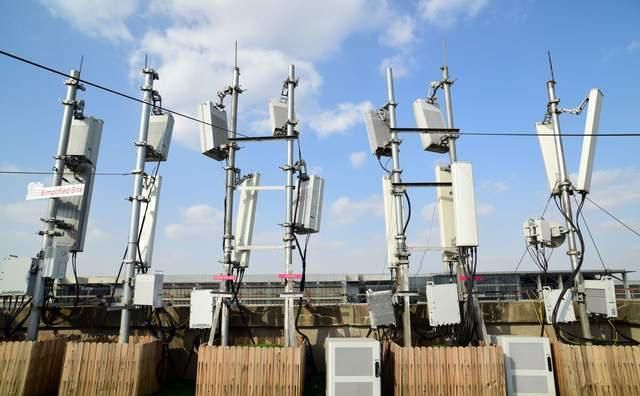Recently, Gao Hongda, a senior researcher at the State Grid Energy Research Institute, pointed out at the “2020 Communication Industry Conference and the 15th Communication Technology Annual Conference” that when 4G is fully upgraded to 5G in 2026, the power consumption of base stations will account for 2.1% of the total electricity consumption in society. At the same time, the coverage area of 5G base stations is far less than that of 4G base stations, which means that the number of base stations required for the comprehensive popularization of 5G is much more than that of 4G base stations, about three times.

The standalone power consumption of 5G base stations is high, and the layout density is also high. According to the above calculation, the total electricity cost of 5G base stations will reach about 10 times that of 4G. Moreover, we know that 5G consumes a lot of power and generates a lot of heat, and the computer room must operate at a specified temperature (18 ° C-28 ° C) to function properly. This is mainly achieved through air conditioning, and data shows that on average, the electricity cost of each base station’s air conditioning accounts for about 54% of the entire base station’s electricity cost.
And it is expected that China will build 8 million 5G base stations by 2025. How much electricity will this cost?
According to industry insiders’ estimates, 100000 5G base stations require at least 2 billion yuan in electricity bills per year, so 8 million 5G base stations require at least 160 billion yuan in electricity bills per year. What is this concept? The three major telecom operators had a total profit of about 130 billion yuan in 2019, which means they may have to use all their profits to pay for electricity bills.
Why does the base station consume electricity?
The following presents the results of professional frontline testing, with the power consumption of Huawei and ZTE 5G base stations shown on the graph. As the two leading companies in the construction of 5G base stations in China, Huawei and ZTE have previously released power consumption data for 5G equipment. Huawei and ZTE’s 5G base stations have a 100% load power consumption of 3852.5W and 3674.85W, respectively, while ZTE’s 4G base station has a power consumption of only 1044.72W under 100% load, indicating that the energy consumption of 5G base stations is more than three times that of 4G.
| Equipment type | Traffic load | ZTE | HUAWEI | ||
| AAU/RRU average power consumption (W) | BBUaverage power consumption (W) | AAU/RRUaverage power consumption (W) | BBUaverage power consumption (W) | ||
| 5G | 100% | 1127.28 | 293.012 | 1175.4 | 325.8 |
| 50% | 892.32 | 293.012 | 956.8 | 325.8 | |
| 30% | 762.43 | 292.537 | 856.9 | 319 | |
| 20% | 733.92 | 293.233 | 797.5 | 319 | |
| 10% | 699.36 | 293.416 | 738.6 | 319 | |
| No load | 633 | 293.568 | 663.10 | 330 | |
| 4G | 100% | 289.68 | 175.68 | ||
| 50% | 273.58 | 174.32 | |||
| 30% | 259.1 | 171.92 | |||
| No load | 22.59 | 169.44 | 236.7 | 286.26 | |
| Traffic load | ZTE 4G(S333) | ZTE 5G(S111) | HAUWEI 5G(S111) | ZTE 4/5G power consumption comparison | |
| 100% | 1044.72W | 3674.85W | 3852.5W | 5G is about 3.5 times that of 4G | |
As the business load increases from control to full load, 5G has increased by approximately three times compared to 4G. The power consumption of 5G base stations has indeed increased significantly, and the increase in power consumption is the key to the increase in power consumption of 5G base stations.
The electromechanical unit is used to process digital signals and calculate data, and then transmit them to the AU module, where the data is converted into modulated high-frequency RF signals. Then the power can be amplified and transmitted to our mobile phones through the base station antenna.
These two modules are the main working parts of 5G base stations, which means that the power consumption of 5G computing is only a part of the overall equipment power consumption of 5G base stations. In addition to other small modules that use electricity, the power consumption of a single 5G base station is generally around 3700 watts, which is about three times that of 4G and does not include the power consumption of air conditioning. For details, please refer to article:”How terrible is the power consumption of 5G base stations?”
Firstly, as mentioned above, the AU module’s processing, conversion, and transmission of data signals is a major power consumption factor. In addition, computing large amounts of data requires extremely high algorithms, which requires high-performance FPGA chips. Finally, there are the supporting facilities for building the website, with air conditioning being a typical example of power consumption. The 5G networking mode generally consists of macro base stations and small base stations.

The reason for such a disparity is that the two use completely different frequencies.
5G base stations use high power consumption and high RF signals, which require more signal processing for digital and electromechanical units, and also put greater pressure on AU modules. But at the same time, it can also provide users with faster signal reception and response.
If 5G signals are used, the power consumption of mobile phone users’ devices will continue to increase, and high-frequency use will also lead to severe heat generation. Severe cases may even affect the lifespan of the equipment. No matter how much heat a mobile phone generates, it is very limited. However, the heat generated by 5G base stations is much higher than that of 4G, which often leads to high temperatures in the workplace. In order to cool down 5G devices and increase their lifespan, a complete air conditioning system is usually installed in the workplace. Most of the time, these air conditioners are in a fully loaded state, and the extensive use of air conditioners will lead to a rapid loss of electricity, especially during summer when power consumption reaches its peak.

Large buildings like Lake base stations are equipped with fully enclosed computer rooms, especially for the heat dissipation of pathogen transmission equipment in new houses during summer. And to maintain normal operation in basic warfare, cooling is necessary, so air conditioning cooling also requires electricity consumption and is not small. Of course, the power consumption of a single base station is only a part of the power consumption of 5G networks, and 5G power consumption still involves an aspect of regional base station networking.
Previously, 4G used two frequency bands: 2300 to 2370 MHz and 2575 to 2635 MHz. The Ministry of Industry and Information Technology of China has confirmed two initial intermediate frequency bands for 5G, namely 3300 to 3600 100MHz. The range of 4800 to 500 is two, because higher frequencies ensure high rates while reducing the penetration of electromagnetic wave signals. The higher the frequency, the smaller the coverage range of base station signals.

If we want to achieve signal coverage of the same area, the deployment of 5G base stations needs to exceed the increase in the number of Level 4 emergencies, which also increases the power consumption of 5G networks. There are two main channel directions for China and the United States to choose from in their research and development of weapons expenditures. The initial intermediate frequency band used for 5G in our country is the SUV New band. And another frequency band is the millimeter wave range of F22, which is between 24 Hertz and 205 Hertz. Due to various limitations of millimeter waves, the United States gradually lost in the 5G era. One advantage of using SUV deployment base stations in the early stages of China’s 5G network construction is that. 5G base stations can be directly installed on the battlefield of 4G base stations, which greatly reduces the cost of 5G networks and does not require additional power consumption.

Poor user experience and high price are the most serious problems facing the nationwide promotion of 5G. So, how should 5G upgrade its technology to gain more consumer favor?

The Development Path of Future 5G
Although one 5G base station after another has been established nationwide, there are not many actual users of 5G. The most critical issue is that the basic users of 5G believe that the high price and poor user experience of 5G are not equal.
In addition, one of the reasons why 5G is still difficult to promote is that 4G can already meet the daily entertainment needs of most people. Therefore, the new features covered by 5G are mostly icing on the cake, rather than providing timely assistance.
Therefore, for the future 5G, the most effective way is undoubtedly through technological upgrades to reduce heat generation, power consumption, and usage costs, in order to compete in a price range similar to 4G. Only then can 5G’s high communication speed demonstrate its true advantages.

Another development approach is to develop product features that are unique to 5G, such as the currently popular Internet of Things and Starlink communication. But this is clearly a 6G issue, and achieving technological breakthroughs in 5G is too difficult and unrealistic.
Therefore, 5G is currently in a neither up nor down state, and the unequal experience and cost make it difficult to win the favor of consumers. If it is not upgraded and transformed, it may become a sacrifice for the arrival of 6G.
Conclusion
There are numerous 5G base station constructions, but it is difficult to promote nationwide 5G due to high power consumption resulting in high costs and consumer dissatisfaction. In the future, 5G will undergo functional upgrades and power consumption reductions to improve the current awkward market situation.
Use new technology to lower the temperature of base stations. A high-speed base station generates a large amount of heat, and in order to ensure that it does not shut down due to high temperatures, the refrigeration system needs to continuously cool it down, which requires a lot of electricity. To solve this problem, operators have adopted technologies such as liquid cooling to enable base stations to operate efficiently at low temperatures, achieving precise cooling and reducing energy consumption, effectively saving electricity costs.
Diversify the diet and increase green energy. Renewable energy sources such as wind energy and photovoltaics are important energy sources for 5G base stations. Operators carry out the construction and deployment of low-carbon base stations to increase the proportion of clean energy. China Mobile is promoting the “5G+Photovoltaic” model in multiple regions, using solar energy to power base stations. Beijing Mobile has a 5G green energy-saving demonstration station with an average annual power generation of about 6000 kWh and an equivalent annual emission reduction of about 5.9 tons of CO ₂.
Co construction and sharing, saving investment costs. Adopting the model of 5G network co construction and sharing can not only quickly form a high-quality 5G network covering the whole country, but also reduce duplicate investment and effectively reduce energy consumption. China Unicom saves over 17.5 billion kilowatt hours of electricity and reduces carbon emissions by over 10 million tons annually through 4G/5G joint construction and sharing.
FAQ:
5G will be shut down at night and turned on during the day due to its high power consumption?
During the night, 5G base stations do not open all functions on a daily basis, but only operate at the lowest threshold, and although 5G devices are sleeping, they can still ensure basic usage for users, only adjusting their self resource power based on the number of users. It is not shut down the base station at night.





